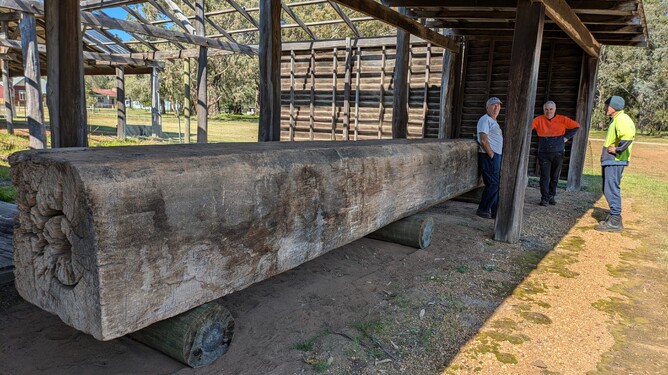The Tuart log (pictured above with L-R Kevin Bray, Phillip Sloan and Mark Kemp) was kindly donated to our group by the Shire of Capel, where it was stored for many years at the Shire Depot. Thanks to Bruce Taylor who negotiated the delivery to the Ludlow Settlement.
There are a couple of competing stories about this log. We are going with this one from our past President, Des Donnelly.
What is the backstory?
As early trade began, all exports had to be go out by sea. As there were no roads in those early years so any food produced in the fertile soil around the estuary was taken to Fremantle by boat to help sustain the colony.
It was not long after the arrival of Europeans that land clearing began, and timber production became the first export income earner supporting the fledgling economy, as timber was in demand around the world. Exploitation of the tuart forest to produce and export timber gathered pace, and on the arrival of the steam power, and the first steam locomotive arrival in WA at Lockville, a new sawmill was built and the accompanying jetty out into the Geographe Bay.
Up until this development, timber was moved by hand and rowed out to waiting ships. The log is a Tuart Buffer Beam and used for a land backed wharf. It was sited at the Vasse/Capel estuary Wonnerup/Lockville.
The beam is squared on four sides using broad axe to finish 800 mm x 800 x 9 metres long. The beam is severely weathered on two faces as a result of saltwater erosion. The ends have been attacked by Toredo borer (Ship Worm) and imbedded with mussel shells indicating a life in the ocean and exposure to saltwater. The other two sides of the Beam are remarkably well preserved, indicating contact with soil.
Where was it found?
It is believed the piece of timber was dislodged during a flood and washed out to sea, and eventually ended up back on shore, and half buried in the sand hills, from where it was recovered by the Shire of Capel workers, and relocated to one of their worksheds, where it has been protected for many years.
What was it used for?
We believe the beam formed a manmade wharf, providing a landing place to enable settlers at Vasse, a more secure and efficient means of docking rowboats, rather than having to wade through water to reach dry land.
The first settlers had to wade ashore and carry their goods and chattels by hand. This was hard work, and the stirred-up mud would have made the going tough.
This landing was used to aid the transfer of imported and exported goods by row boats to ships anchored some distance out to sea.
How old is it?
It could have been installed very early after settlement, probably in the first 5 years after arrival in 1835.
How did they get it to the beach?
To move such a huge beam overland would have required a substantial cattle or horse team to drag it along and manoeuver it into position.
How was it made?
As the export of timber began soon after settlement, the expertise to square, such a large piece of timber would have been by timber-men from England who had the tools, expertise, and experience with broad axe, adz and crosscut saw to fashion such a large piece of timber.
